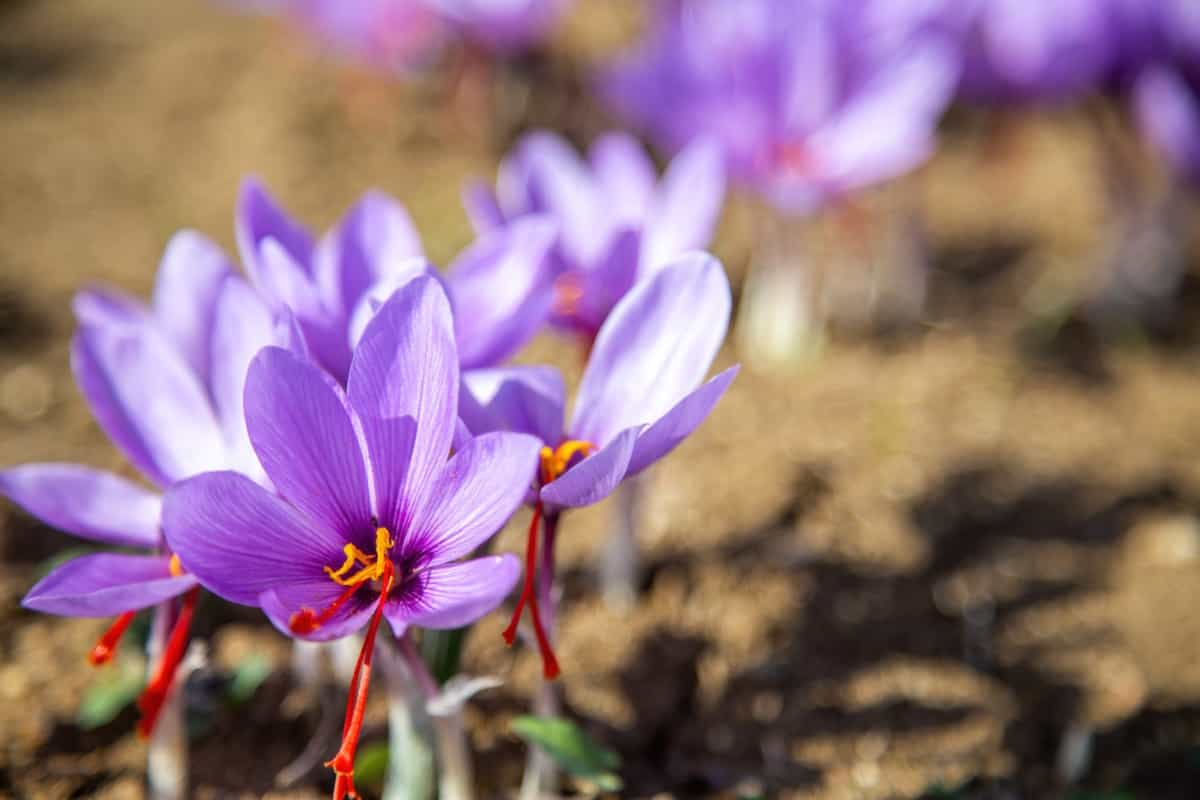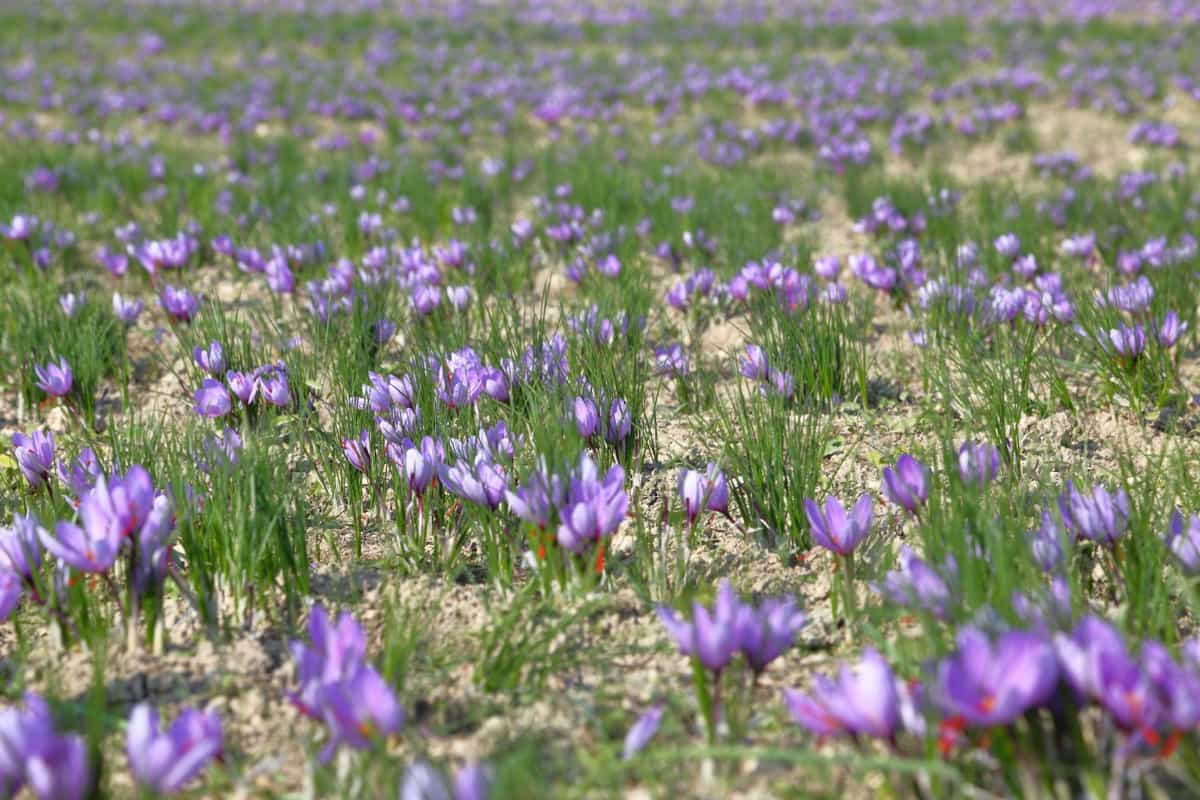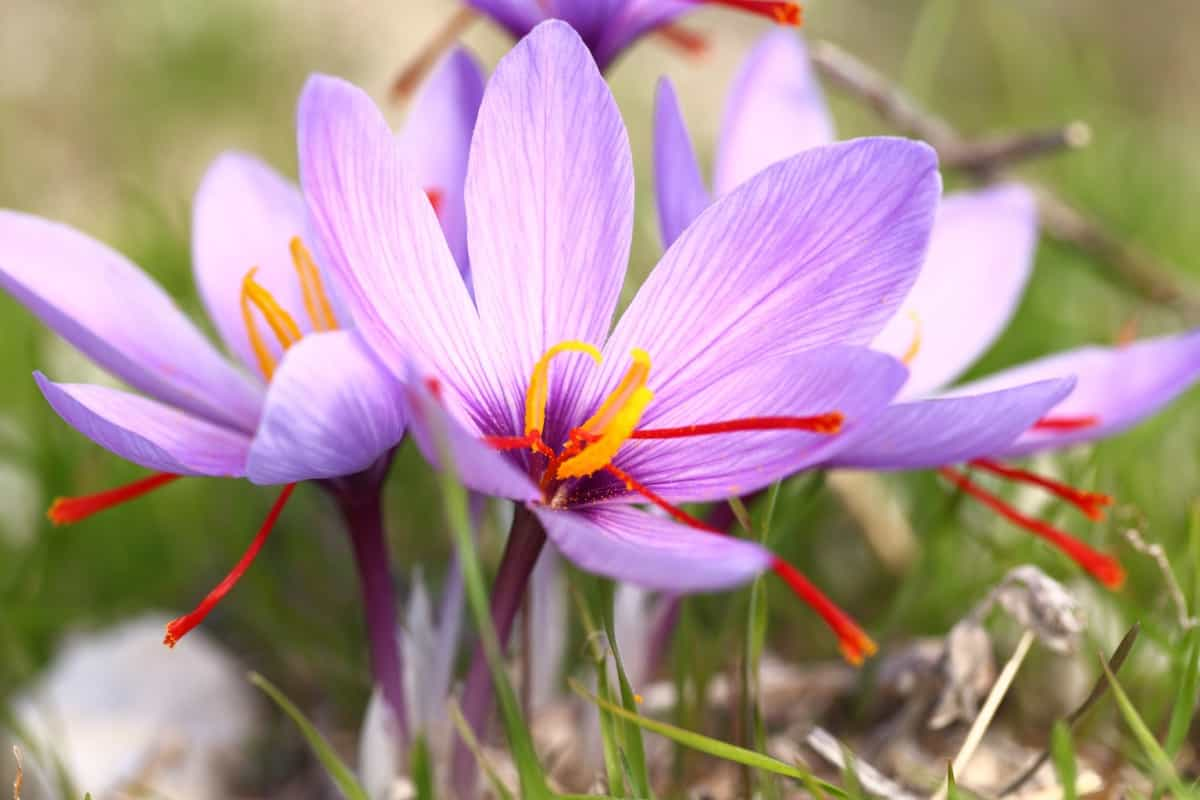Organic Saffron farming refers to the cultivation of Saffron using organic and sustainable methods without the use of synthetic fertilizers, pesticides, or genetically modified organisms (GMOs). In organic Saffron farming, farmers rely on traditional practices such as crop rotation, composting, and integrated pest management. Growing Saffron organically brings numerous benefits, from environmental preservation to increased market opportunities.

Best Practices to Grow Saffron Organically
Understanding Organic Saffron Farming
Organic Saffron farming involves cultivating Saffron crocus flowers using natural methods without synthetic pesticides or fertilizers. This method ensures the final product is free from harmful chemicals and retains its purity and health benefits. To start organic Saffron farming, you must carefully choose a suitable location for cultivation. Selecting high-quality Saffron bulbs is a critical aspect of organic Saffron farming. Choose disease-free bulbs sourced from reliable suppliers to ensure a successful harvest.
Choosing the Right Location for Saffron Cultivation
Choosing the right location for Saffron cultivation is crucial for the success of your organic farming venture. Saffron requires specific environmental conditions to thrive and produce high-quality spice. Saffron thrives in regions with a Mediterranean climate characterized by dry summers and mild winters.
It requires a distinct temperature variation between seasons, triggering the flowering process. Saffron needs full sun exposure to grow optimally. The soil should be well-drained and have good fertility levels. Conduct a soil test before planting Saffron bulbs to ensure appropriate pH levels.
Preparing the Soil for Organic Saffron Farming
Soil preparation is a crucial step in organic Saffron farming. The soil quality directly affects the growth and yield of Saffron flowers. It is essential to test the pH level of the soil. Saffron thrives in slightly acidic soils with a pH range between 6 and 7. Adding organic amendments like compost or aged manure can significantly enhance soil fertility and provide essential nutrients for healthy plant growth.
Selecting High-Quality Saffron Bulbs
The quality of the bulbs directly impacts the yield and quality of Saffron produced. Choose bulbs that are plump and firm to the touch. Avoid any soft, shriveled, or damaged bulbs, as they may not produce healthy plants. Look for bulbs with multiple daughter corms attached. These smaller corms have the potential to grow into new plants and increase your overall yield over time.
In case you missed it: How to Propagate Saffron Bulbs: Best Techniques for Sprouting Saffron Bulbs

Additionally, choose bulbs with vibrant red stigmas protruding from them. This indicates that they are mature and ready for planting. Moreover, check if the bulb has a well-defined neck at its top. A distinct neck ensures better anchorage in the soil during growth. Furthermore, sourcing Saffron bulbs from reputable suppliers specializing in organic varieties is advisable. They will be able to provide you with certified organic bulblets that meet industry standards.
Planting and Caring for Saffron Crocus
It requires careful attention to ensure the growth and development of these delicate flowers. To start, choose a well-drained location with full sun exposure for planting the Saffron bulbs. The soil should be loose, fertile, and slightly acidic. Next, select high-quality Saffron bulbs from a reputable source.
The bulbs should be firm and plump, without any signs of mold or damage. Plant them about 4-6 inches deep in small groups or clusters. Once planted, provide regular watering, but avoid overwatering as it can lead to bulb rotting. Saffron crocus prefers a dry period during its dormant phase. Caring for Saffron crocus involves dividing and replanting bulbs every few years to prevent overcrowding and maintain healthy plant growth.
Organic Pest and Disease Management in Saffron Farming
One effective method of pest control in organic Saffron farming is companion planting. This involves intercropping Saffron with other plants that naturally repel pests or attract beneficial insects. For example, planting marigolds around your Saffron beds can help deter aphids and nematodes.
Regular monitoring is essential to catch any potential pest infestations early on. Inspecting your plants regularly allows you to identify damage signs or the presence of pests such as mites or thrips. Taking prompt action when needed can prevent further spread and minimize the impact on your crop. In cases where pest or disease pressure becomes too high to manage organically, approved biological control options are available for use on certified organic farms.
Irrigation Methods for Organic Saffron Cultivation
Irrigation is a crucial aspect of organic Saffron cultivation, as it directly affects the growth and quality of the flowers. Proper irrigation methods ensure that the Saffron crocus receives adequate water without causing waterlogging or rotting of bulbs. The effective method is drip irrigation, which provides water to the root zone through a network of tubes and emitters.
In case you missed it: Soil and Climate Requirements for Saffron Farming

This approach helps conserve water by minimizing evaporation and ensuring precise delivery to each plant. Another option is furrow irrigation, where shallow channels are created between rows of Saffron plants. Water is then allowed to flow slowly along these channels, seeping into the soil and reaching the roots. Mulching can be done around the Saffron plants to enhance moisture retention further.
Timing plays an important role in irrigation management for organic Saffron farming. Different stages, such as bulb formation, flowering, and dormancy periods, require varying amounts of water. They understand these specific requirements, which aids in optimizing crop yield and quality while minimizing wastage.
Harvesting and Processing Organic Saffron
Harvesting Saffron is a delicate and time-sensitive process that requires precision and care. The flowers of the Saffron crocus bloom for only a short period, usually in the autumn months. When harvesting organic Saffron, it is essential to use gentle methods to preserve the precious threads’ integrity. Hand-picking each flower allows for precise selection and ensures that only fully matured stigmas are harvested.
This manual, labor-intensive process may be time-consuming but guarantees top-notch quality. After harvesting, the next step is processing the Saffron threads. This involves carefully drying them to remove moisture while preserving their vibrant color and aroma. Traditionally, this was done by spreading the threads on trays or screens under shade until completely dried. To maintain its organic status, avoiding chemical treatments or additives during processing is crucial.
Certification Process for Organic Saffron Farming
The first step in the certification process is choosing a recognized certifying agency specializing in organic agriculture. They will guide you through the application process and periodically inspect your farm to ensure compliance with organic standards. Once certified as an organic Saffron producer, you are entitled to use labels or logos the certifying agency provides on your packaging materials or marketing collateral. This stamps authenticity onto your product and helps consumers identify genuine organically grown Saffron.
Market Opportunities and Challenges in Organic Saffron Production
Organic Saffron production allows farmers to tap into this growing market by offering a premium product free from harmful chemicals and pesticides. By obtaining certification for organic Saffron farming practices, farmers can attract eco-conscious consumers willing to pay a higher price for quality and sustainability.
Additionally, the global culinary industry has recognized Saffron’s unique flavor and aroma, leading to increased demand. Organic pest management requires careful monitoring and proactive measures to prevent infestations while adhering to strict pesticide use guidelines.
Frequently Asked Questions (FAQ) Growing Saffron Organically
Are There Any Natural Ways for Controlling Pests and Diseases in Organic Saffron Production?
Yes. Organic farmers rely on integrated pest management techniques such as crop rotation, companion planting, and biological control methods like releasing beneficial insects that prey on pests. Regularly monitoring plants helps identify early signs of disease or infestation so appropriate measures can be taken promptly.
In case you missed it: How to Create a Saffron Farming Business Plan: From Cultivation to Marketing

Is it Necessary to Use Chemical Fertilizers in Organic Saffron Farming?
No, chemical fertilizers are not used in organic Saffron farming. Instead, natural alternatives such as composted or green manure cover crops that nourish the plants and promote healthy growth.
Why is Organic Saffron Farming Important?
Organic Saffron farming is crucial for several reasons. It ensures the final product is free from harmful chemical residues, making it safer for consumers. It helps maintain soil fertility and promotes a healthy ecosystem by avoiding chemical inputs that can harm beneficial insects and microorganisms. Organic Saffron commands a premium price in the market due to its superior quality.
Conclusion
Organic Saffron cultivation eliminates the use of synthetic pesticides and fertilizers. Farmers contribute to protecting the health of consumers and ecosystems by choosing organic Saffron farming methods. Additionally, growing Saffron organically promotes biodiversity by preserving natural ecosystems.
- Feed Your Flock for Less: Top 10 Tips to Save on Chicken Feed
- Ultimate Guide to Ossabaw Island Hog: Breeding, Raising, Diet, and Care
- Hatching Answers: The Top 10 Reasons Your Chickens Aren’t Laying Eggs
- Eggs and Economics: Breaking Down the Cost of Raising Backyard Chickens
- Defend Your Greens: Proven Methods to Keep Iguanas Out of Your Garden
- Ultimate Guide to Cinnamon Queen Chicken: A Comprehensive Guide for Beginners
- Ultimate Guide to California Tan Chicken: Breeding, Raising, Diet, Egg-Production and Care
- Ultimate Guide to Marsh Daisy Chicken: Breeding, Raising, Diet, and Care
- 10 Types of Chicken Farming Businesses You Can Start for Profits